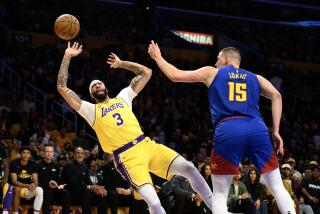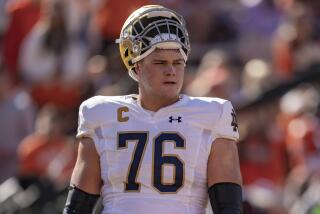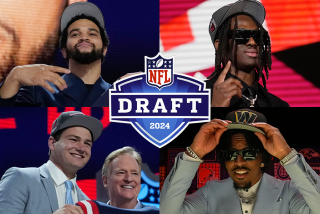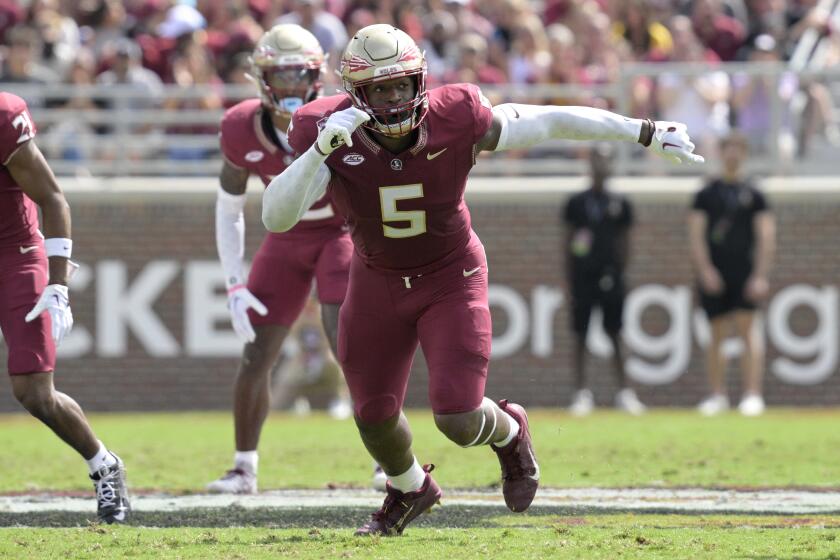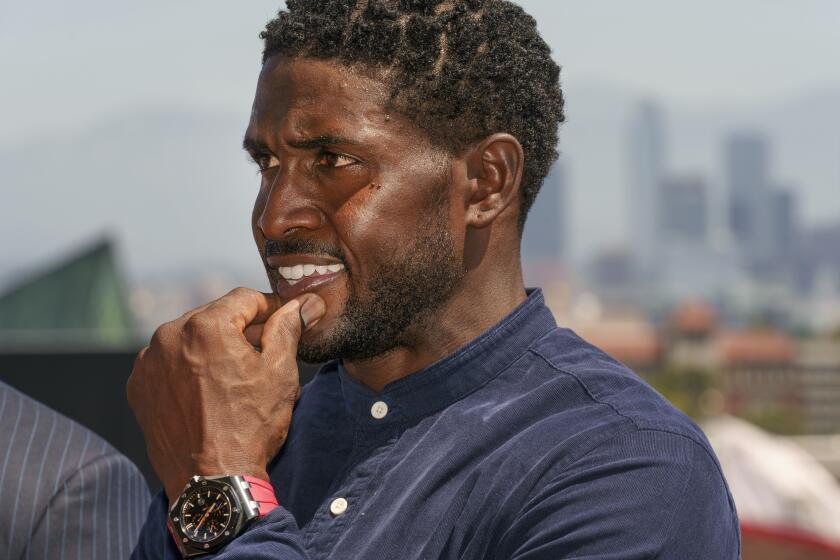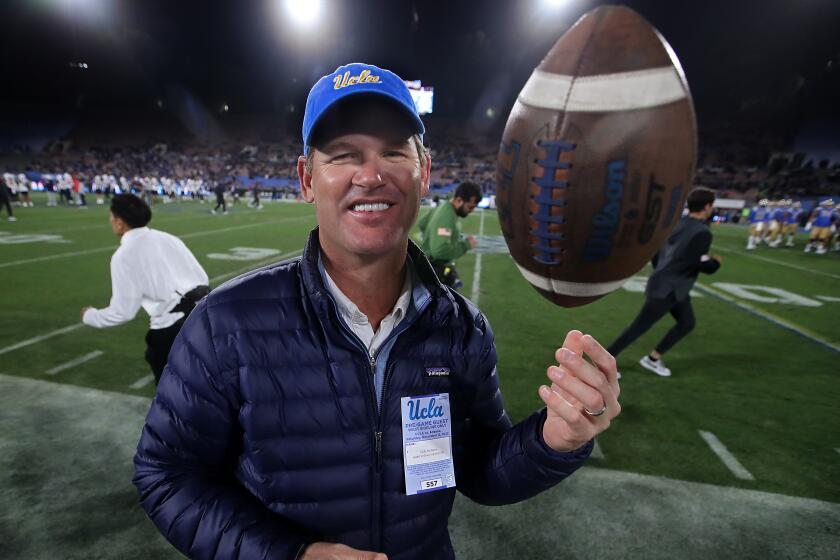Weis Blew It
Longtime writer Bob Oates shares his commentary on the NFL.
When onetime NFL coaches Pete Carroll of USC and Charlie Weis of Notre Dame were cranking up last week for the football game of the year — college or pro — Weis apparently confided to at least three newspaper reporters: “I own Pete Carroll.”
But does he? I don’t think so. I’d say Weis blew the game. On a pleasant Indiana day, before USC won dramatically, 34-31, he blew it by recurrently asking his running backs to play ball-control football in a losing effort to keep the Trojan offense off the field.
In pro football, what happened to Notre Dame in the USC game usually happens to running teams relying on ball-control tactics against good passing teams.
Weis learned the hard way that the same thing can also happen in college football.
For, clearly, it’s all but impossible to successfully play ball control for 60 minutes against a quarterback like Matt Leinart when his pass offense is as sharp as USC’s.
As some Notre Dame fans have suggested, the great flaw in Weis’ reasoning is that he underrated his own pass offense. In his first year as Notre Dame coach, he’s inherited one of the finest quarterbacks in college football, Brady Quinn, who played well enough against the Trojans to earn the Heisman Trophy if the Fighting Irish had won.
Quinn, obviously under orders to proceed cautiously, opened up but once. That time, after Reggie Bush’s third masterful touchdown run had with only 5:09 left put USC ahead, 28-24, Quinn was authorized to come out passing for the first time in 55 minutes. And, shortly, his aggressive response overwhelmed the USC defense with a series of passes that were as spectacular as they were accurate. On a breathtakingly efficient 85-yard drive, Quinn in three minutes regained the lead for Notre Dame, 31-28.
As a pro coach at New England, Weis normally played that kind of aggressive football with quarterback Tom Brady to win three of the last four Super Bowls. And at South Bend, he has a leader who already rivals Brady as a passer. But for reasons that remain unclear, Weis chose to face Leinart the way he played Peyton Manning last year when he beat the Indianapolis Colts by keeping Manning off the field.
Weis’ strategic approach in his first USC-Notre Dame game showed that he badly misread the USC quarterback. As of last year, Weis knew that Manning can be rattled. Too late, he knows now that Leinart can’t.
Leinart’s Winning Sneak Recalls Starr’s
LEINART BEAT WEIS with two plays at the end of a grueling day for Leinart in which Weis’ team beat him up but couldn’t break him. The first of these decisive plays was the 61-yard deep sideline pass to Dwayne Jarrett — thrown on fourth and nine — that moved the Trojans into position for the tying field goal if Carroll had had any interest in that, which he hadn’t.
A long pass down the sideline was precisely the right call on that fourth-down play against that team at that moment, and a defining thing about Leinart is that he had the courage and aggressiveness to call it, at the end of a long, difficult game, in the noise and pressure created by a Notre Dame crowd that was there to rattle him.
The call illustrated, once more, that Leinart has an unusual football mind that works in suffocating pressure even when he’s exhausted. For to get the right play into the biggest game he’s played yet, he had to block out the noise from the Notre Dame fans and change a coach’s call from the sideline. And of course Leinart’s big pass illustrated that he has the arm to do what he should do and wants to do.
The more celebrated of Leinart’s two winning plays was the touchdown-scoring quarterback sneak. It was reminiscent of Bart Starr’s game-deciding sneak in the so-called Ice Bowl game nearly 40 years ago, when, like Pete Carroll, Green Bay Coach Vince Lombardi played not to tie but to win. To score, Leinart got an illegal but essential assist from Reggie Bush, who stormed up from his tailback position and shoved him across the goal line with both hands. The officials, watching the ball as well as the goal line, didn’t see it.
So Leinart and Bush — who was unstoppable on touchdown runs of 36, 45 and nine yards — belong as the 2005 co-Heisman winners, if there’s any way to do that. And if there were any way to lift USC’s offensive team bodily into the NFL this year, it would improve at least half the clubs in pro football. None of them ever produced a game like Saturday’s — most conspicuously when Quinn or Leinart was throwing or when Bush was running.
Steelers Super Team Only with Big Ben
THE PITTSBURGH STEELERS will go into their AFC North matchup at Cincinnati next Sunday in second place (by 1 1/2 games) to the division-leading Bengals, whose new quarterback, Carson Palmer, has done everything he had to do to beat five of the six middle-of-the-pack opponents he has encountered so far.
He couldn’t bridge the Jacksonville defense a few weeks ago. Nor, in Week 6, could Pittsburgh — with backup Tommy Maddox at quarterback. When Big Ben Roethlisberger is out of the Pittsburgh lineup, as he was that day, the Steelers are just another parity team this year in the oh-so-even NFL.
The Jaguars not only carried the Steelers into overtime but beat them when an intercepted Maddox pass was returned for the winning touchdown, 23-17. Playing hurt, Maddox threw some sound passes but made some schoolboy plays. There were times in other years when Maddox seemed to be the answer for the Steelers. Not now. It’s even less likely that third-stringer Charlie Batch is a savior.
When Roethlisberger returns — which could be as soon as Sunday, the medics say — he will be asked to carry the Steelers into the Super Bowl. That is putting considerable pressure on a second-year pro. Still, when he’s on the field, his team does seem to be the NFL’s best.
The Bengal-Steeler game could be a giant stride for him and his teammates — or for Palmer and the Bengals — toward where they all want to go. In other years, the Bengals were duck soup for a team as good as Pittsburgh. Now they’re a test.
It Takes Leftwich Too Long to Throw
THE JAGUARS under Coach Jack Del Rio, a former USC linebacker, have developed a title-contending defense that looked as aggressive and powerful against Pittsburgh as it had against Carson Palmer. In short, it looked like any other finely tuned NFL defense. But Del Rio has an offensive problem at quarterback.
Although his passer, Byron Leftwich, has modern quarterback size (6 feet 5, 245 pounds) and good accuracy, it takes him too long to throw the ball. He starts a typical Jaguar pass play with a big, old-fashioned, time-consuming stride and proceeds with a big, time-consuming, old-fashioned, roundhouse passing motion that will cripple his team until they fix it.
Someone has to teach Leftwich the modern, compact, Joe Namath passing motion that Tom Brady, among others, uses to such good purpose today and that made a two-time Super Bowl champion of John Elway. Before he learned it, Elway had lost three Super Bowls when harmed by an ineffective, old-fashioned passing style that closely resembles the present Leftwich style.
Old pro quarterback Ken Anderson, who is on Del Rio’s staff, should help Leftwich here, but if not Anderson, somebody must. Meanwhile, the Jaguars are winning with their defense, which can get them to second place in their division but not their conference.
Cowboys Making New Man of Bledsoe
THE DALLAS COWBOYS held off the New York Giants in overtime by a less-than-awesome 16-13 score Sunday in the NFC East headliner. Because they’re making a new man of Drew Bledsoe, their new quarterback, the Cowboys could survive an uninspiring game of mistakes. Doubtless to the dismay of the city of Buffalo, where Bledsoe was ineffective last year, he has Dallas in first place in the NFL’s oldest division.
Before the game, Dallas Coach Bill Parcells had shown Bledsoe how to solve his passing problem — which is an inability to get the ball off against a hard, up-the-middle rush. Just throw it on first down, Parcells urged, and for a while that worked pretty well, Bledsoe completing eight of nine passes on the 83-yard drive that left the Cowboys ahead of the Giants at halftime, 7-6.
Then the Giants started blitzing Bledsoe on first down, whereupon a strange thing happened. He began completing some on second and even third down. For the day, he completed 26 of 37 for 312 yards, meaning, perhaps, that under Parcells’ careful handling he’s thriving. The Giant passer, Eli Manning, couldn’t keep up, in part because, when the game was there to be won by either side, his side showed a preference for running the ball.
In sum, this was a day that showed the downside of parity football. When the players are of about even ability, the game can either be ragged or crowd-pleasing. This one was ragged.
Is Gibbs Moving into the 21st Century?
THE WASHINGTON REDSKINS, locked in a three-way second-place tie a half-game behind Dallas in the NFC East, may have played their best game Sunday since the second coming of Joe Gibbs. Though they lost it in the last two minutes before a noisy Kansas City crowd — on a Trent Green pass to Priest Holmes — their new quarterback, Mark Brunell, outplayed Green most of the way.
Brunell led the league in passing that day with 331 yards and three touchdown throws measuring, in order, four yards for a 7-6 halftime lead, and 75 and 11 yards in the third quarter to earn a 21-21 tie going into the fourth quarter of Gibbs’ long battle against one of the NFL’s most explosive offenses.
Conventional wisdom that the AFC is stronger than the NFC — particularly in pass offense — was tested on a Missouri day when the visitors won the statistics first to last. This suggested that Gibbs, after a successful 20th-century tour as a running-play advocate, may be moving his team, and himself, into a new century.
The Patriot Way to Pro Football Parity
THE NEW ENGLAND PATRIOTS, now 3-3 with a team that was the best in the land when its defense was hale and hearty, have found a new way to play .500 football: Just lose all your defensive talent to injury. This and nothing else has taken the Patriots out of the NFL and into the NPL — the National Parity League.
After they had fallen behind at Denver, 28-3, quarterback Tom Brady weathered the loss of his first two running backs, Corey Dillon and Kevin Faulk — on top of New England’s defensive absentees among other injured starters — to mount one of the NFL’s finest ever near-comebacks.
But for a dropped pass by the team that rarely drops passes — the dropper this time was David Givens, who drops even fewer than the Patriot average — Brady would have been in position to win it at the end. The league’s best passer made the Patriots’ famous but depleted offense look about as good as ever in the second half, when, as Brady surged, the winning quarterback, Jake Plummer of Denver, was held to seven points.
Bob Oates can be reached at oatesinla@aol.com. Previous columns are available at latimes.com/oates.
More to Read
Get our high school sports newsletter
Prep Rally is devoted to the SoCal high school sports experience, bringing you scores, stories and a behind-the-scenes look at what makes prep sports so popular.
You may occasionally receive promotional content from the Los Angeles Times.
